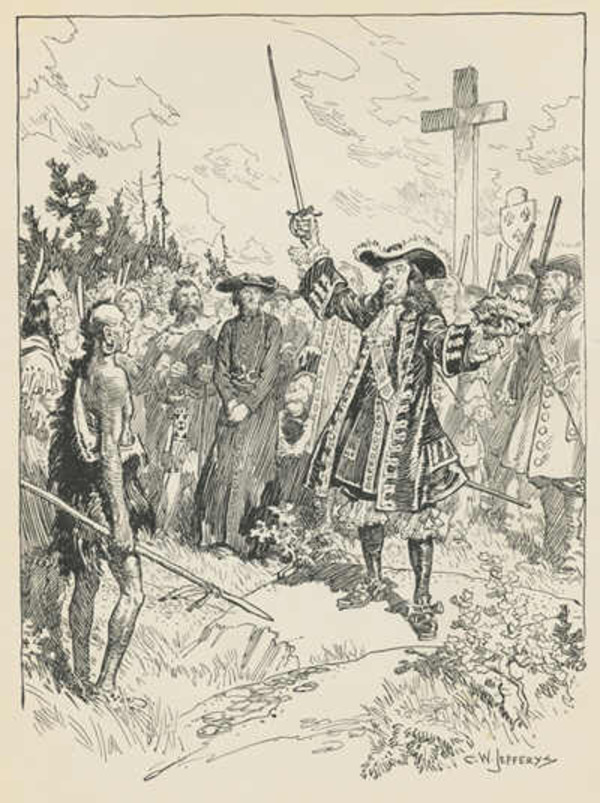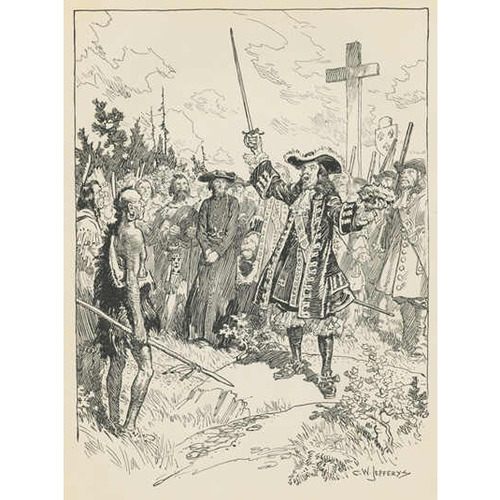
Source: Courtesy of Wikimedia Commons
DAUMONT DE SAINT-LUSSON, SIMON-FRANÇOIS, regimental officer, explorer; d. sometime after 11 Nov. 1677.
He arrived at Quebec probably in 1663, together with the investigating commissioner Gaudais-Dupont. In January 1664 he obtained a tract of the Hébert fief, near Beauport, which was to cause him legal complications from 1668 to 1671.
On 3 Sept. 1670 Intendant Talon appointed him a deputy commissioner “to seek out the copper mine in the country of the Ottawas, the Nez-Percés [Amikoues], and the Illinois, and of other nations discovered or to be discovered in North America in the region of Lake Superior or Freshwater Sea.” What was being undertaken was a systematic study of the country, following the accounts brought back by the first travellers and the details supplied by the first explorers Cavelier de La Salle, Bréhant de Galinée, Dollier* de Casson, Adrien Jolliet, and Marquette. Indeed Daumont de Saint-Lusson, as well as making soundings at the Lake Superior copper mine, was to attempt to discover the northwest passage in a northerly direction, whereas La Salle was instructed to proceed towards the “southern sea.” It was Talon’s reply to the English expansion into Hudson Bay.
Saint-Lusson, accompanied by the interpreter Nicolas Perrot*, left Montreal in October 1670 via the Ottawa River, Lake Nipissing, the Rivière des Français (French River), and the Great Lakes; he went ashore at the village of Sault Ste. Marie, where the Jesuits maintained a fairly prosperous mission. On 4 June 1671 he called together all the Indian nations that could be reached; there were 14 of them.
In the presence of this important gathering of nations and a few prominent Frenchmen a ceremony took place which had important diplomatic consequences. The interpreter Perrot, in the name of the king of France, began to read in the Indian language from the document that confirmed the appropriation by France of this immense territory, discovered and yet to be discovered, which stretched from the seas of the north and west to that of the south. Then they erected a cross, “to bring forth there the fruits of Christianity,” and immediately beside it a cedar post bearing the arms of France. As the crowd, made up of both French and Indians, uttered repeated cheers of “Long live the king,” a “sod of earth” was lifted in the air three times, in a symbolic gesture. Henceforth this part of a continent belonged to the king of France, and these 14 nations were dependent on His Majesty and subject to his laws and customs. In return they could count on his protection. The French intoned the Vexilla Regis, to the great wonderment of the Indians. Then Father Allouez delivered a harangue to the Indians in which he extolled the power of Louis XIV, “the Captain of the greatest Captains.” Daumont de Saint-Lusson then spoke, and expressed himself “in martial and eloquent language.” In the evening a splendid bonfire was lighted, presents were exchanged, and a Te Deum was sung to thank God, in the Indians’ name, for having made of them “the subjects of so great and powerful a Monarch.”
Some Hurons and Ottawas, who arrived late for the ceremony, likewise swore allegiance to Louis XIV. Saint-Lusson’s official journey, which cost the king of France nothing and which added a segment – somewhat symbolically it is true – to his empire, in fact marks the beginning of the planned explorations that were to lead to James Bay, the Gulf of Mexico, and the Rocky Mountains.
As soon as Saint-Lusson returned to Quebec late in the summer of 1671, he was again sent on a mission, with instructions to proceed with the establishment of a means of communication between Quebec, Pentagouet (Castine, Maine), and Port-Royal (Annapolis Royal, N.S.), and to examine a copper deposit in Acadia. He returned the following 11 November, half-dead: “the sieur de Saint-Lusson returns from Pentagouet,” Talon reported to the minister, “but so broken down by the fatigue of his journey, and so enfeebled by the hunger he suffered, that I doubt his ability to go to France, whither I should be very glad he would repair to have the honor to inform you, in person, what he saw at the Rivers Pemcuit and Kiniliki.” Consequently the intendant, after extolling the explorer’s courage and devotion, seized this opportunity to solicit for him a post at Quebec or in Acadia.
However, Saint-Lusson made a rapid recovery, since he embarked soon afterwards on the Saint-Jean-Baptiste, bound for Dieppe. He reached there in January 1672, bringing exotic mementoes: “A live moose about six months old, a fox and 12 large wild geese, which he hastened to go and present to the king.” On 3 November of the same year he was granted the Île aux Lièvres seigneury, in the lower St. Lawrence region. On the following 31 December he was already back in New France, since he was present at the signing of the marriage contract between Jean Demosny and Catherine Fol at Quebec.
What became of him subsequently? All we know is that at an undetermined date he returned to the mother country, whence he was preparing to get back to the colony in the spring of 1677; this is revealed by the correspondence of Abbé Dudouyt with Bishop Laval*. Indeed on the 12 May M. Dudouyt wrote from Paris: “Saint-Lusson is making ready to go back to Canada without knowing what he will do there. I am likewise afraid that he will be what he was before.” In another letter he noted: “Monsieur de Saint-Lusson is returning to Canada with no clear notion of what he should do. I see no change in his conduct; he says he wants to live differently from before.” These comments, less flattering than the intendant’s, appear to lend veracity to an enigmatic remark by Bacqueville de La Potherie [Le Roy*] on the subject of Saint-Lusson’s expedition to Sault Ste. Marie: “his behaviour on that undertaking was so disorderly, to say nothing stronger,” wrote La Potherie, “that I will content myself with reporting that he was dispatched to Acadia to be sent back to France.”
About Saint-Lusson’s family we possess nothing but confused and fragmentary information. According to Talon’s letter of 11 Nov. 1671 to the minister, Saint-Lusson had at that period a wife and daughter in France, as well as another daughter in the colony. The latter is probably the “Magdeleine daumont St Lusson” whose signature appears on Demosny’s marriage contract, and who is mentioned in the Armorial de France of d’Hozier as being the daughter of Simon-François Daumont de Saint-Lusson and Marguerite La Verge. On the other hand Tanguay’s dictionary gives Marguerite Bérin as the name of Saint-Lusson’s wife. Did the explorer marry twice? That is a matter for conjecture. We know, however, that Saint-Lusson and Marguerite Bérin had a son, Jean-Baptiste, who was born on 24 June 1673 in the parish of Notre-Dame de Québec. Be that as it may, this Marguerite Bérin must not be confused, as has often been done, with her namesake Marguerite Berrin, who married Julien Bouin on 2 July 1675; at that date Saint-Lusson was still alive, and moreover Marguerite Berrin was never the widow of Julien Bouin, who survived her and married again in July 1684. Finally, Saint-Lusson is said to have had a son, christened Jean-Baptiste, in June 1673.
ASQ, Lettres, N, 482e, p.10; S, 93, p.5. Coll. de manuscrits relatifs à la Nouv.-France, I, 213, 217–18. Correspondance de Talon, APQ Rapport, 1930–31, 159, 165, et passim. Découvertes et établissements des Français (Margry), I, 87f., 92–99. JR (Thwaites), LV, 104–14. Jug. et délib., I, III. La Pot(h)erie, Histoire, II, 124–30. NYCD (O’Callaghan and Fernow), IX, 74, 803f., et passim. Perrot, Mémoire (Tailhan), 126–28, 290–95. P.-G. Roy, Inv. concessions, II, 274f.; III, 116.
BRH, XLVI (1940), 159f. Delanglez, Jolliet. Faillon, Histoire de la colonie française, III, 307–9. Ernest Gagnon, Louis Jolliet, découvreur du Mississipi et du pays des Illinois, premier seigneur de l’île d’Anticosti (Montréal, 1946), 48–59. Godbout, “Nos ancêtres,” APQ Rapport, 1959–60, 325. Lionel Groulx, Notre grande aventure: l’empire français en Amérique du Nord (1535–1760) (Montréal et Paris [1958]). L. P. d’Hozier et A.-M. d’Hozier de Sérigny, L’armorial général, ou registres de la noblesse de France (6 registres en 10v., Paris, 1738–68). P.-G. Roy, “Jean Peré et Pierre Moreau dit la Taupine,” BRH, X (1904), 219. Benjamin Sulte, “Les Français dans l’Ouest en 1671,” RSCT, 3d ser., XII (1918), sect.i, 1–31. Tanguay, Dictionnaire, I, 159.
Revisions based on:
Bibliothèque et Arch. Nationales du Québec, Centre d’arch. de Québec, CE301-S1, 24 juin 1673; CN301-S95, 11 nov. 1677.
Cite This Article
Léopold Lamontagne, “DAUMONT DE SAINT-LUSSON, SIMON-FRANÇOIS,” in Dictionary of Canadian Biography, vol. 1, University of Toronto/Université Laval, 2003–, accessed January 19, 2026, https://www.biographi.ca/en/bio/daumont_de_saint_lusson_simon_francois_1E.html.
The citation above shows the format for footnotes and endnotes according to the Chicago manual of style (16th edition). Information to be used in other citation formats:
| Permalink: | https://www.biographi.ca/en/bio/daumont_de_saint_lusson_simon_francois_1E.html |
| Author of Article: | Léopold Lamontagne |
| Title of Article: | DAUMONT DE SAINT-LUSSON, SIMON-FRANÇOIS |
| Publication Name: | Dictionary of Canadian Biography, vol. 1 |
| Publisher: | University of Toronto/Université Laval |
| Year of publication: | 1966 |
| Year of revision: | 2015 |
| Access Date: | January 19, 2026 |



